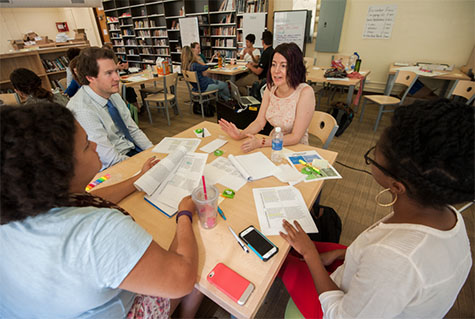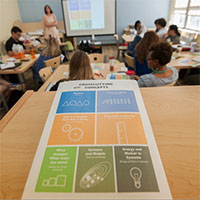
Launching this month, Hawthorn Leadership School for Girls will offer sixth and seventh-grade girls a rigorous education in science, technology, engineering and math (STEM). But Hawthorn’s curriculum covers more than formulas and algorithms, said founder Mary Danforth Stillman.
“What makes us unique is not that we teach science and math – who doesn’t?” Stillman said. “It’s our approach. We are committed to developing the vital 21st-century skills of collaborating and problem-solving. We believe in learning that comes from asking questions, working as a team, interpreting data, testing solutions and communicating your results.”
Hawthorn is the region’s first all-girls charter school. Located on N. Kingshighway in St. Louis, the school ultimately will serve 500 girls in grades 6-12. Enrollment is open and tuition is free. The school is affiliated with the successful Young Women’s Leadership Network, which was founded by Washington University alum and Board of Trustees member Ann Rubenstein Tisch.

Washington University in St. Louis is both Hawthorn’s sponsor and its partner. Educators with the university’s Institute for School Partnership have been working closely with Hawthorn leaders for more than
a year to develop the school’s project-based curriculum and real-world
philosophy.
“We have a track record of helping teachers
catalyze change in their classrooms,” said Victoria L. May, executive director of the ISP. “In a lot of schools, students are asked to read a textbook and
answer a worksheet. We know that is not how any of us learn. You would
never teach someone to be an artist just by giving them an art history
book.”
Hawthorn will use the Next Generation Science Standards’ nationally recognized “Crosscutting Concepts” as the foundation for all learning. The concepts — patterns; cause and effect; energy and matter in systems; scale, proportion and quantity; structure and function; systems and models and stability and change of systems — are the big ideas that connect all of the sciences.

But Kimberly Weaver, ISP engineering educator, said they apply to the humanities and the arts too. She said Hawthorn teachers, no matter what class they teach, will reinforce these concepts daily.
“If you understand cause and effect, you not only get chemistry but you probably also have a good grasp of history,” Weaver said. “The point is to help the students to become thinkers in all subjects, not just STEM. If you teach students this fact or that fact, eventually you are done. But if you teach these skills and how to connect ideas from different subjects, the learning never ends.”
Weaver and other ISP educators recently provided extensive training to Hawthorn teachers. Weaver, who has developed the school’s engineering curriculum, said Hawthorn students will complete sixth grade knowing more about engineering than she did as a freshman engineering major. She said the “E” is often missing in STEM education.
“Engineering education is easy to do poorly and hard to do well,” Weaver said. “A lot of times, it’s, ‘Here’s a box of straws. Here’s some paperclips. Let’s build a tower.’
“That’s not the whole story of engineering; that’s tinkering,” she said.
“Engineering is a very deliberate process that focuses on asking questions, defining problems, visualizing solutions, understanding criteria and constraints.”
Weaver said schools often limit engineering education to after-school clubs. At Hawthorn, the subject will be part of the daily curriculum. Weaver also will help lead quarterly “Drop Everything and Build” days, where students and faculty will join together to tackle design challenges.
“We need to get the students who don’t think they are engineers to think they are engineers,” Weaver said. “There will be that opportunity at Hawthorn. We will be reaching everyone, not just the ones who already are part of a First Lego League or a robotics club.”
Stillman hopes Hawthorn’s unique approach to STEM education will create a new generation of female scientists. Studies show that women in STEM jobs earn 33 percent more than those in non-STEM occupations, and experience a smaller wage gap relative to men.
“Middle school is often a time when girls drift away from math and science,” said Stillman, a product herself of an all-girls secondary education. “We, as a nation, suffer the consequences of that reality. If we are to meet to enormous challenges of this century, we need everyone’s talents.”